inscribed and dated "From a Lane nr Hele Village Ilfracombe Sep 1863" and signed with initials "LWT"
Tom and Laura Taylor and thence by descent
This view is probably near Hele on the single-track lane between Goosewell and Hele - but it could also be on what is now the B3320 to Ilfracombe when it was single-track road.
Broadstrands beach below Hillsborough was created one night in 1851 by a landslip. A few years later Philip Gosse published A Naturalist's Rambles on the Devonshire Coast. He describes Hele as seen from Hillsborough; "Now for a gaze inland. Under our feet is the village of Hele, emblossomed in gardens and orchards, and half hidden by tall and shaggy elms.....we look down upon extensive gardens sloping away from our feet to the cottages on the road side. Opposite us rises a broad hill-side covered with fields of corn and potatoes. Between there is the valley, the village-mill, the 'one arch'd bridge' crossing the brook, and the brook itself now in full view brawling and sparkling away to the Cove".
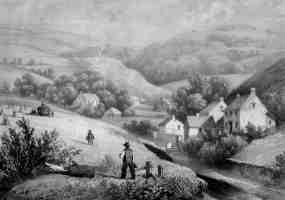 Contemporary prints support this romantic idyll (above left and right). The print on the left, looking down the valley, shows the 1830 turnpike road to Barnstaple, with Hele in the distance. There are some buildings at the bottom of Hillside Road (then the main road to Ilfracombe) and below this a farm which Gosse called the Tea Garden Inn, to the right are a cluster of cottages beside the mill. The print on the right, looking up the valley, shows the mill in a group of trees, the cottages in Hele Close (now Beach Road) are on the right. They are difficult to recognise, but the cottage perpendicular to the stream is now part of 13 Beach Road. The two cottages beyond it have been demolished, the cottage on the extreme right is now part of a terrace of three flat-roofed cottages and the cottage beyond that is now 11 Beach Road. Gosse wrote "the houses are partly placed around the base of Hillsborough, up whose steep sides the gardens extend, and partly up a lovely valley. A brawling brook comes down through this wooded glen, turns the village mill-wheel, and runs off to the sea between two walls, one of which forms a causeway about a yard in width, between the cottage-doors and the water-course".
Contemporary prints support this romantic idyll (above left and right). The print on the left, looking down the valley, shows the 1830 turnpike road to Barnstaple, with Hele in the distance. There are some buildings at the bottom of Hillside Road (then the main road to Ilfracombe) and below this a farm which Gosse called the Tea Garden Inn, to the right are a cluster of cottages beside the mill. The print on the right, looking up the valley, shows the mill in a group of trees, the cottages in Hele Close (now Beach Road) are on the right. They are difficult to recognise, but the cottage perpendicular to the stream is now part of 13 Beach Road. The two cottages beyond it have been demolished, the cottage on the extreme right is now part of a terrace of three flat-roofed cottages and the cottage beyond that is now 11 Beach Road. Gosse wrote "the houses are partly placed around the base of Hillsborough, up whose steep sides the gardens extend, and partly up a lovely valley. A brawling brook comes down through this wooded glen, turns the village mill-wheel, and runs off to the sea between two walls, one of which forms a causeway about a yard in width, between the cottage-doors and the water-course".
 The Tithe map (left) shows a lime kiln beside the beach, which may have been still in use. The strange 'dagger' symbol to the right probably denotes an uncertain boundary. The Tithe transcription reveals that the properties in Hele Close were held by John Lee, Dolly Irvine and Francis Cutcliffe. Further along were gardens rented by Richard Rotenbury and Ann Maybey, then buildings at the bottom of Hillside Road held by John Berry. The fields to the top of Hillside road were held by Richard Harding; he also held the fields down to and including the Tea Garden Inn. These lands were all part of Hele Bay Estate, owned by the Walters’ family. Hele village belonged to the adjoining Chambercombe Estate, owned by George and John Vye.
The Tithe map (left) shows a lime kiln beside the beach, which may have been still in use. The strange 'dagger' symbol to the right probably denotes an uncertain boundary. The Tithe transcription reveals that the properties in Hele Close were held by John Lee, Dolly Irvine and Francis Cutcliffe. Further along were gardens rented by Richard Rotenbury and Ann Maybey, then buildings at the bottom of Hillside Road held by John Berry. The fields to the top of Hillside road were held by Richard Harding; he also held the fields down to and including the Tea Garden Inn. These lands were all part of Hele Bay Estate, owned by the Walters’ family. Hele village belonged to the adjoining Chambercombe Estate, owned by George and John Vye.

Although the properties in Beach Road were held by only 3 families in the 1839 Tithe, the 1841 Census shows that there were 30 people living there, in seven families: Lewis, Hill, Pugsley, Ley (Lee), Parker, Irwin (Irvine) and Cuttipp (Cutcliffe). The first small cottages were probably beside the stream; perhaps they flooded and when larger houses were built, they were sited further back . By the 1851 Census there were 48 people living in Beach Road, the total population of Hele being 166. Some of these families have familiar names. The Moon's for example, may be related to the maker of Joe Moon's Caves on Hillsborough (see lime-burning). Perhaps John Galliver, given by profession as a limeburner/journeyman, still used the kiln on the beach during the winter. John Hill, who held the mill, was the local blacksmith and is said to have also been the dentist and policeman! John Wilkey and William Stevins are said to have waylaid a smuggler's wagon on its way to South Molton (see smuggling). Descendents of some of these families (e.g. Parker, Galliver and Watts) still live in Hele today, over 150 years later.
Between approximately 1840 to 1860, larger houses were built back from the stream and Hele Close became known as Beach Road. This photograph of 1897 (above right) shows the lower part of Beach Road before the stream was covered over. On the right of the photograph is the lime kiln, beneath which there is a heap of coal. Below this, in the stream, there is a cart, used to carry coal up the stream to the road, where there was a slipway. Number 9 (now 25) Beach Road is on the extreme left; this was held by John Galliver the Elder until he died in 1859, when it passed to Maria Parker (who later became Rees) and his sons William and John. Perhaps the young girl shown in the photograph is Eve, John the Elder's granddaughter.
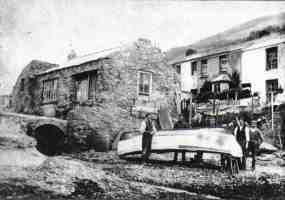 The houses nearest the beach were occupied by the Lewis'; then a common name in Ilfracombe (there were 63 Lewis' in Ilfracombe in 1851). No doubt they were constructed by Nicholas Lewis, a stone mason. His son William, a carpenter and fisherman, is said to have built several boats beside the beach, including one called the Saucy Lass. This photograph (left) is said to show William Lewis in 1875, standing in front of one of his boats. The stone shed which he used as a store later became Lewis’ Tearooms and then Bayside Cafe. By the 1891 Census there were four Lewis families in Beach Road. Note the bridge over the stream; anything delivered by boat would have to be handled twice to get to the road.
The houses nearest the beach were occupied by the Lewis'; then a common name in Ilfracombe (there were 63 Lewis' in Ilfracombe in 1851). No doubt they were constructed by Nicholas Lewis, a stone mason. His son William, a carpenter and fisherman, is said to have built several boats beside the beach, including one called the Saucy Lass. This photograph (left) is said to show William Lewis in 1875, standing in front of one of his boats. The stone shed which he used as a store later became Lewis’ Tearooms and then Bayside Cafe. By the 1891 Census there were four Lewis families in Beach Road. Note the bridge over the stream; anything delivered by boat would have to be handled twice to get to the road.
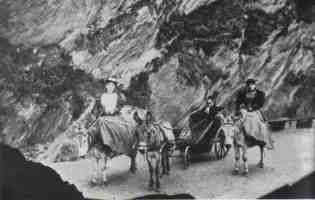
Gosse found Hele to be "inhabited chiefly by gardeners, laundresses, donkey-keepers and other persons, whose subsistence is largely dependent on summer visitors to Ilfracombe." Donkeys were kept by the local women, originally for delivering laundry and then for conveying tourists. The 1891 Census called Maria Rees a donkey chair proprietor and her daughter Sally Galliver (who later took over the business) a donkey chair driver. The average charge was 6d. for ½ mile and 8d. for 1 mile. Donkeys were kept on the coastal slope east of the beach, which consequently became known as Donkey Island. In 1884 W Walters wrote "There is an open and spacious shingle beach at Hele Bay, which is thought by many will be used largely for bathing purposes at no distant date"; this appears to have been the case, since the 1891 Census gives Joseph Cutcliffe's occupation as Bath Chair Proprietor.
The rapid growth in Beach Road was mirrored in the rest of Hele. A Chapel, also used as a Mission School, was built in 1820 at the bottom of Hillside Road (now demolished; some of its back wall can still be seen behind the public telephone box). A National School (now a private house) was built in 1865 near the Tea Garden Inn and in 1868 a new Turnpike road opened between Ilfracombe and Combe Martin (see Turnpikes). Before this, the main route was inland, along Berrynarbor Lane; the coastal route was only a lane (known as Hockey Lane) to the edge of Hele Bay Estate. From Hele there were two routes up the hill to Ilfracombe; along Hillside Road, or past the Tea Garden Inn (the latter route has now gone). The new turnpike road went right between them. The toll-house, beside the old Chapel, appears to have been a Newsagents and there were toll gates across the turnpike road until 1888.
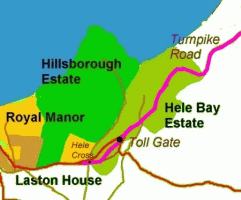 In the 1890's builders expressed interest in developing Hillsborough Estate, owned by Mr Bowen May. To save the land from developers, Ilfracombe Council purchased the Estate for the town in 1895 for £7,500. This included the coastline from Rapparee Cove around to Hele Beach (left). Rapparee & Larkstone Coves were still part of what was left of Ilfracombe Royal Manor; as was Brimlands. Larkstone cottage and Laston House were owned by the Copner family, who had previously owned Hillsborough Estate.
In the 1890's builders expressed interest in developing Hillsborough Estate, owned by Mr Bowen May. To save the land from developers, Ilfracombe Council purchased the Estate for the town in 1895 for £7,500. This included the coastline from Rapparee Cove around to Hele Beach (left). Rapparee & Larkstone Coves were still part of what was left of Ilfracombe Royal Manor; as was Brimlands. Larkstone cottage and Laston House were owned by the Copner family, who had previously owned Hillsborough Estate.
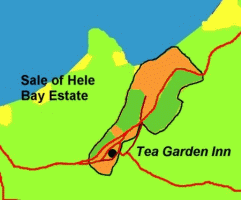
Hele Bay Estate was now owned by the Fosse family (who inherited from the Walters). Somehow a local developer, Thomas Upton, managed to acquire a share; perhaps he knew that the Ilfracombe Gas Company were interested in Hele because of it’s proximity to the beach (the gas works for Ilfracombe were then behind Church Street, a built-up area and inconvenient to supply with coal). In 1895 the Gas Company bought Hele Bay Estate for £5,700 . The following year they disposed of the land they didn't need in a public sale (right); the rest was retained (shown orange), including the Tea Garden Inn (later the site of the gas works) and the properties beside the road and stream leading down to the beach - they may have originally been planning to construct a harbour in the Bay. Over the next few years many local residents bought properties that they had formerly leased.
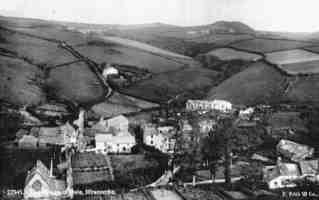
Just before the end of the century, Hele was still a rural idyll. It is said that salmon used to swim up the stream and the millponds were full of eels. This Francis Frith postcard of Hele Village (left) shows the Tea Garden Inn to the right and the National School to the left. Lilian Wilson remembered that "Hele was a very pretty small village.... just the mill and the farm, two small streams, the mill pond and about 30 houses..... [the Tea Garden Inn] used to be such a lovely place. It was an apple and cherry orchard with a stream running along the side and a tea room where people out for a walk or ride could linger and have refreshments. It was especially beautiful when the trees were in bloom" but that was all just about to change! In 1898 the Tea Garden Inn burned down and the Hele Bay Hotel was built, the first building east of the stream below the mill. Two shops were built on the main road in 1900: 18 Watermouth Road was a post office and general store, number 19 was a cobblers.
Laura Wilson Barker (6 March 1819 – 22 May 1905), was a composer, performer and artist, sometimes also referred to as Laura Barker, Laura W Taylor or "Mrs Tom Taylor".
She was born in Thirkleby, North Yorkshire, third daughter of a clergyman, the Rev. Thomas Barker. She studied privately with Cipriani Potter and became an accomplished pianist and violinist. As a young girl Barker performed with both Louis Spohr and Paganini. She began composing in the mid-1830s - her Seven Romances for voice and guitar were published in 1837. From around 1843 until 1855 she taught music at York School for the Blind. During this period some of her compositions - including a symphony in manuscript, on 19 April 1845 - were performed at York Choral Society concerts.
On 19 June 1855 she married the English dramatist, critic, biographer, public servant, and editor of Punch magazine Tom Taylor. Barker contributed music to at least one of her husband's plays, an overture and entr'acte to Joan of Arc (1871), and provided harmonisations as an appendix to his translation of Ballads and Songs of Brittany (1865).
Her other works include the cantata Enone (1850), the violin sonata A Country Walk (1860), theatre music for As You Like It, (April 1880), Songs of Youth (1884), string quartets, madrigals and solo songs. Her choral setting of Keats's A Prophecy, composed in 1850, was performed for the first time 49 years later at the Hovingham Festival in 1899. The composer was present.
Several of Barker's paintings hang at Smallhythe Place in Kent, Ellen Terry's house.
Barker lived with her husband and family at 84 Lavender Sweep, Battersea. There were two children: the artist John Wycliffe Taylor (1859–1925), and Laura Lucy Arnold Taylor (1863–1940). The Sunday musical soirees at the house attracted many well-known attendees, including Lewis Carroll, Charles Dickens, Henry Irving, Charles Reade, Alfred Tennyson, Ellen Terry and William Makepeace Thackeray.
Tom Taylor died suddenly at his home in 1880 at the age of 62. After his death, his widow retired to Porch House, Coleshill in Buckinghamshire, where she died on 22 May 1905, aged 86.

